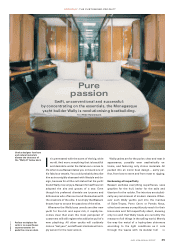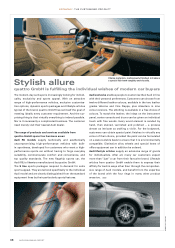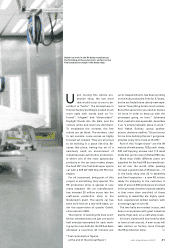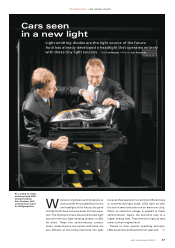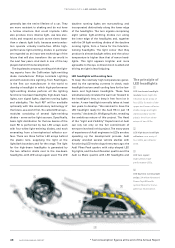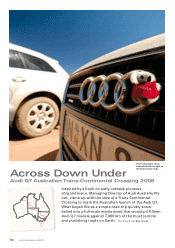Audi 2006 Annual Report Download - page 45
Download and view the complete annual report
Please find page 45 of the 2006 Audi annual report below. You can navigate through the pages in the report by either clicking on the pages listed below, or by using the keyword search tool below to find specific information within the annual report.
Personnel are only admitted to the
paint shop via prescribed routes, and all
must wear protective clothes. They for
instance have to pass through air locks
on their way to the top-coat painting
booths.
As well as giving the R8 body its indi-
vidual appearance, the paintwork meets
a whole range of other requirements. Its
properties include resistance to chemi-
cals, long-term stability, resistance to
scratching and impact from flying
stones, imperviousness and corrosion
resistance. One paint coating alone
would be unable to meet all these re-
quirements. The desired result is ob-
tained through the combination of dif-
ferent, coordinated coating processes.
Employees
The craft-scale assembly of the R8 de-
mands very high qualifications and
considerable experience from the 100
or so workers. Many employees who
were involved in Technical Develop-
ment and Prototype Construction were
thus retained for series production of
the Audi R8.
In launching the pilot project “Audi
Silver Line”, Audi is also responding to
demographic change by focusing on
and specifically seeking to utilise >>
“The inline measuring
technology provides
an indication of the
quality and dimensional
accuracy of each body.
The measuring points
are represented
three-dimensionally
and evaluated.”
The cycle time in assembly is approximately
44 minutes.
Top left, opposite: the three sub-assemblies
for the body are welded together by hand.
Bottom left, opposite: the Audi R8 is
assembled in 14 work cycles.
TECHNOLOGY: AUDI R8 PRODUCTION
PHOTOS: AUDI
43AUDI 2006 ANNUAL REPORT
52 connecting points for the running
gear and steering are machined in the
milling centre, and holes and threads
formed in the body. Because the R8
features suspension with motor-racing
traits, maximum precision in the con-
necting points is absolutely imperative.
The bodies, now finished apart from
the add-on parts, are then measured in
a contactless laser process. 90 laser
measuring heads scan about 185 meas-
uring points on each body in less than
five seconds. This so-called inline meas-
uring technology provides an indication
of the quality and dimensional accuracy
of each body. The measuring points can
be represented three-dimensionally and
evaluated. These ongoing dimensional
accuracy checks mean that any adjust-
ments needed to the fixtures and com-
ponents can be made straight away.
All add-on parts such as the front lid
and doors are precision-fitted to the
body in the framing station. The gap
and functional dimensions are adjusted
individually to the target value for every
vehicle. This guarantees that the add-on
parts function well and have excellent
build quality.
The body manufacturing process is
completed by finishing the outer skin’s
surface over the entire body.
Once the vehicle identification num-
ber has been stamped on, the R8 body
can be forwarded to the paint shop.
Paint shop
This is where the sports car’s body is
painted, on the same production line
as the Audi A8 and the Lamborghini
Gallardo. Buyers of the R8 can choose
from eight basic colours: Jet Blue
(which is exclusive to the R8), Phantom
Black, Ice Silver, Monterrey Green, Day-
tona Grey, Brilliant Red, Ibis White and
Mugello Blue. In order to obtain a su-
perlative paint finish for these colours,
the paint must be applied in immacu-
lately clean conditions. The entire paint
shop has consequently been divided up
into four clean-room zones. A slightly
higher air pressure is maintained inside
the building compared with its sur-
roundings, to prevent particles of dirt
from finding their way into the paint
shop.
Body shop
This is how the Audi R8* takes shape as
a top-quality product: the super sports
car is steered through production ac-
cording to the “string-of-pearls” princi-
ple. The string-of-pearls idea means
that a fixed assembly sequence in which
all the scheduling criteria of the various
production areas are incorporated is laid
down even before body manufacturing
has started.
In the production process itself, the
sequence determined before the start
of body manufacturing is then adhered
to precisely. The aim is sequence fidelity
of at least 96 percent.
The Audi R8 has passed through 17
stations in the body shop in Hall B14
by the time it reaches final assembly.
99.9 percent of the body is made from
aluminium, with just a few parts made
from plastic. Here again, the many years
of experience and expertise of the
Neckarsulm body shop in the domain of
aluminium bodies is exploited.
The R8 body tips the scales at just 240
kilograms, and complete with all add-on
parts such as doors and lids the alu-
minium shell weighs 270 kilograms.
The cycle time in the body shop is
44 minutes. This means that the produc-
tion capacity, on a two-shift basis, is
20 cars a day. The level of automation
of just 25 percent underlines the char-
acter of a bespoke article. 38 welding
machines, five sets of riveting tongs,
five robots, 37 hand-held devices and 13
welding stations are used in the produc-
tion of the Audi R8. Around 70 workers
operate these facilities, which occupy a
floor space of 3,570 square metres.
At the start of the body manufacturing
process, the three sub-assemblies – for-
ward structure, central floor and rear-
ward structure – are welded together
by hand in various fixtures. These sub-
assemblies form the substructure of
the R8.
* fuel consumption figures at the end of the Annual Report




